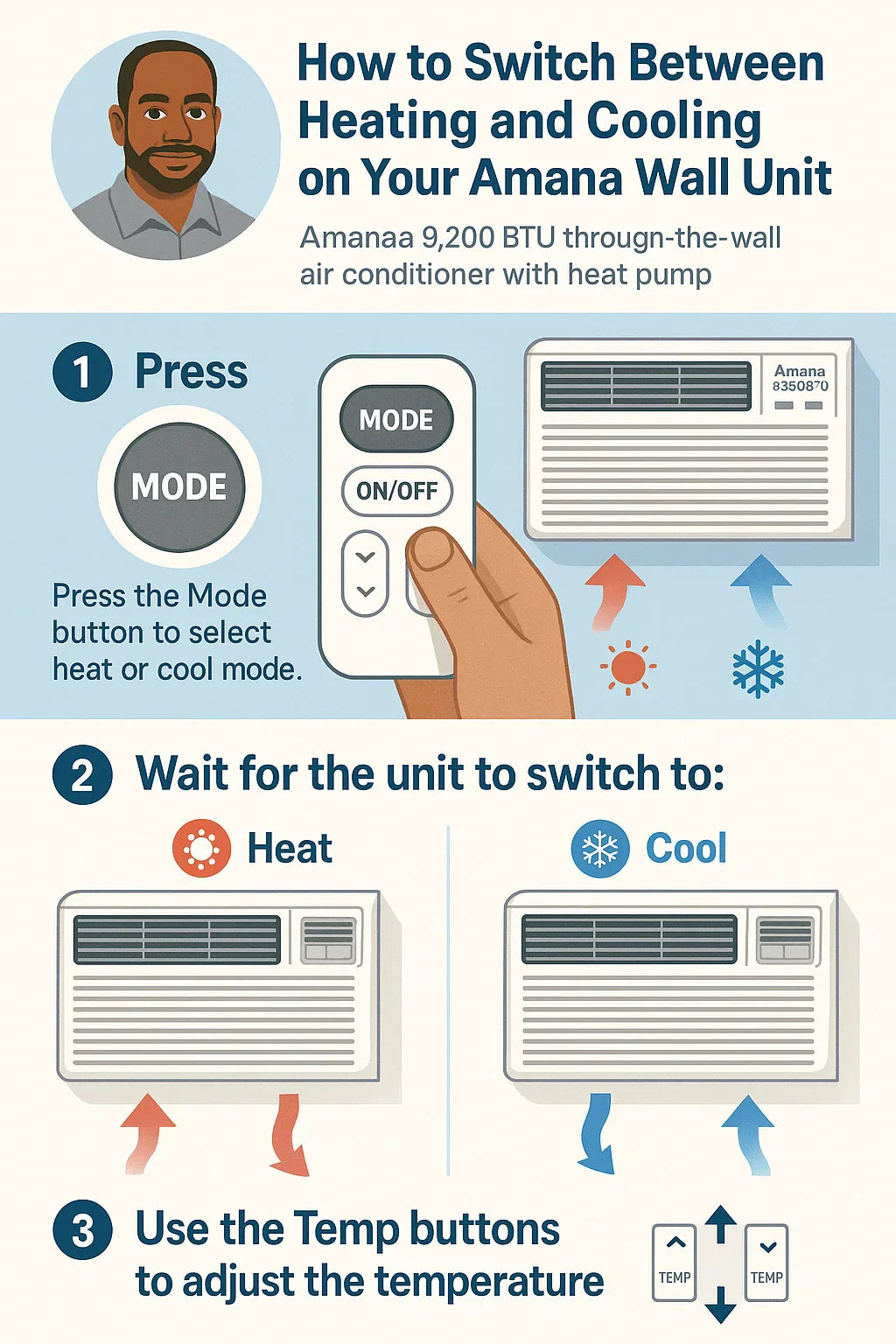🏠 Introduction: Year-Round Comfort Starts with the Right Settings
One of the key advantages of the Amana 9,200 BTU Through-the-Wall AC with Heat Pump is its ability to provide both cooling in summer and heating in winter — all from the same compact, wall-mounted unit.
But if you're like Mark, a homeowner looking for simplicity and efficiency, you might wonder:
"How exactly do I switch modes on my Amana wall unit — and how can I be sure it's working the way I want it to?"
This guide explains everything:
-
How the mode switching works
-
What each setting on your remote or control panel means
-
How to avoid common pitfalls
-
Tips for optimal comfort and efficiency
🎛️ 1. Understanding Your Amana Unit’s Control Panel & Remote
Your Amana wall unit comes with either:
-
A touch-sensitive control panel on the front panel
-
A wireless remote control (often with LCD screen)
🔘 Common Buttons You'll See:
| Button | Function |
|---|---|
| Mode | Switches between Cool, Heat, Fan, Auto, Dry |
| Fan | Adjusts fan speed (Low, Med, High, Auto) |
| Temp ▲▼ | Sets the desired temperature |
| On/Off | Powers the unit |
| Swing | Controls louver direction (if available) |
📌 The “Mode” button is what you’ll use to switch between heating and cooling.
🌬️ 2. How to Switch from Cooling to Heating (and Vice Versa)
Here’s a step-by-step guide for Mark and other homeowners using either the remote or control panel:
📲 Using the Remote:
-
Press “On” to power up the unit
-
Press the “Mode” button until “Heat” appears on the display
-
Use the Temp ▲▼ to set your desired room temperature
-
The unit will activate heating mode and reverse refrigerant flow
To switch back to Cooling, repeat the same steps and stop when the display shows “Cool.”
🧱 Using the Built-In Panel:
-
Tap the Mode icon to cycle through operating modes
-
Stop when the HEAT indicator illuminates
-
Adjust setpoint temperature with ▲ or ▼
🔄 Remember: Switching modes may take up to 3–5 minutes to fully transition, especially for heat pump reversal.
⚠️ 3. Important Things to Know When Switching Modes
🧊 1. Don’t Rapidly Switch Between Modes
-
Let the system complete its cycle before switching again
-
Rapid toggling can stress the compressor or trigger a safety lockout
🔥 2. Heating Mode Requires Outdoor Coil Defrost
-
If you hear a clicking or buzzing during heating, the unit may be defrosting the coil
-
This is normal and temporary
🧯 3. Power Off Before Long-Term Inactivity
-
Leaving the system in Auto mode may cause unneeded cycling during spring/fall
🔗 Amana PTAC Owner’s Manual Example
🧠 4. What Each Mode Actually Does
| Mode | Function | Best Use |
|---|---|---|
| Cool | Cools room to set temperature | Summer or hot days |
| Heat | Heats room to set temperature | Winter or cold nights |
| Fan | Circulates air only | Spring/fall ventilation |
| Auto | System picks heat/cool as needed | Transitional seasons |
| Dry | Dehumidifies without major cooling | Humid, rainy days |
🚫 Mark’s Tip:
“Don’t use Dry mode thinking it’ll heat or cool — it’s just for removing humidity. Great for stormy weather, though.”
🔌 5. What If Your Unit Won’t Switch Modes?
Before calling for service, try these troubleshooting steps:
🔋 1. Check the Remote
-
Replace the batteries
-
Reset remote by removing batteries for 60 seconds
⚡ 2. Power Cycle the Unit
-
Unplug for 5 minutes and plug back in
-
This resets internal circuit board
🧰 3. Check the Temperature Setpoint
-
Heat mode won’t engage if the room is already warm
-
Cool mode won’t activate if the set temp is higher than room temp
🛠️ 4. Check for Obstructions
-
Filters or vents blocked = improper airflow
If nothing helps, contact a certified technician to inspect the reversing valve or thermostat control board.
🔗 Amana PTAC Troubleshooting Guide
💡 6. Energy-Saving Tips for Each Mode
❄️ In Cooling Mode:
-
Set thermostat between 74°F and 78°F
-
Close curtains during daytime sun
-
Clean filter monthly
🔥 In Heating Mode:
-
Set thermostat between 68°F and 70°F
-
Keep doors closed to limit heat loss
-
Insulate window frames and outlets
🔁 Use Auto Mode Wisely
-
Great for moderate climates
-
Avoid using when outside temps swing quickly — may cause the system to overreact
🔗 Energy.gov – Thermostat Settings Guide
📦 7. Using the Amana 9,200 BTU Unit as Your Primary System
The Amana wall unit can be your main HVAC source in:
-
Bedrooms (150–350 sq ft)
-
Enclosed porches
-
Home offices
-
Studio apartments
Switching between modes properly ensures:
-
Year-round comfort
-
Reduced electric bills
-
Maximum system lifespan
🧠 Mark’s Routine: A Real-World Example
“In spring and fall, I keep it on Auto mode during the day, but manually switch to Heat on cooler nights. In the summer, I use Fan mode on mild days and Cool mode during heat waves. It’s all about adjusting with the weather and watching that humidity.”
🛠️ Final Checklist: Mastering Heating and Cooling Modes
✅ Familiarize yourself with remote and control panel
✅ Press “Mode” to cycle through Cool → Heat → Fan → Dry
✅ Set temperature based on season
✅ Don’t switch rapidly between modes
✅ Clean your filters monthly
✅ Adjust louvers to optimize air distribution
✅ Use Auto mode with caution during transitional weather
In the next topic we will know more about: Maintenance Tips for Your Amana Through-the-Wall AC/Heat Pump Combo







